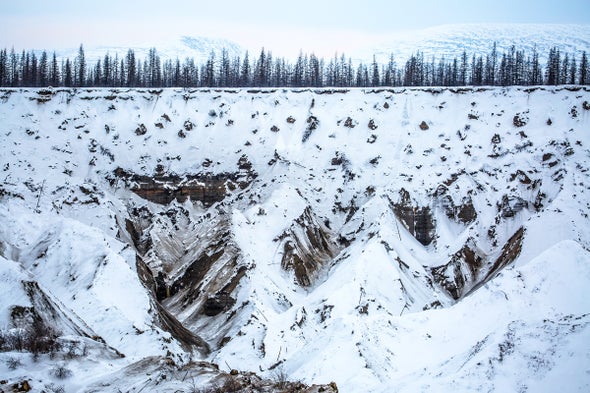In August 2019, Iceland held a funeral for the Okjökull Glacier, the first Icelandic glacier lost to climate change. The community commemorated the event with a plaque in recognition of this irreversible change and the grave impacts it represents. Globally, glacier melt rates have nearly doubled in the last five years, with an average loss of 832 mmw.e. (millimeters water equivalent) in 2015, increasing to 1,243 mmw.e. in 2020 (WGMS). This high rate of loss decreases glacial stores of freshwater and changes the structure of the surrounding ecosystem.
In the last 10 years, warming in the Arctic has outpaced projections so rapidly that scientists are now suggesting that the poles are warming four times faster than the rest of the globe. This has led to glacier melt and permafrost thaw levels that weren’t forecast to happen until 2050 or later. In Siberia and northern Canada, this abrupt thaw has created sunken landforms, known as thermokarst, where the oldest and deepest permafrost is exposed to the warm air for the first time in hundreds or even thousands of years.
As the global climate continues to warm, many questions remain about the periglacial environment. Among them: as water infiltration increases, will permafrost thaw more rapidly? And, if so, what long-frozen organisms might “wake up”?
Permafrost covers 24 percent of the Earth’s land surface, and the soil constituents vary with local geology. Arctic lands offer unexplored microbial biodiversity and microbial feedbacks, including the release of carbon to the atmosphere. In some locations, hundreds of millions of years’ worth of carbon is buried. The layers may still contain ancient frozen microbes, Pleistocene megafauna and even buried smallpox victims. As the permafrost thaws with increasing rapidity, scientists’ emerging challenge is to discover and identify the microbes, bacteria and viruses that may be stirring.
Some of these microbes are known to scientists. Methanogenic Archaea, for example metabolize soil carbon to release methane, a potent greenhouse gas. Other permafrost microbes (methanotrophs) consume methane. The balance between these microbes plays a critical role in determining future climate warming.
Others are known but have unpredictable behavior after release. New evidence of genes moving between thawing ecosystems indicates a restructuring at multiple levels. In the Arctic Ocean, planktonic Chloroflexi bacteria recently acquired genes used for degrading carbon from land-based Actinobacteria species. As melt-swollen Arctic rivers carried sediments from thawing permafrost to the sea, the genes for processing permafrost carbon were also transported.
Permafrost thaw in Siberia led to a 2018 anthrax outbreak and the death of 200,000 reindeer and a child. But the hardy spores of Bacillus anthracis may represent an exception to the brutal freeze-thaw cycle that degrades more delicate bacterial and viral pathogens. Their adaptable characteristics have allowed them to remain frozen and viable over centuries of inactivity.
Organisms that co-evolved within now-extinct ecosystems from the Cenozoic to the Pleistocene may also emerge and interact with our modern environment in entirely novel ways. A potential example, the emerging Orthopoxvirus species Alaskapox causing skin lesions, has appeared and disappeared in Alaska twice in the last five years. It is possible that the virus was transmitted through animal-human contact, but this novel virus’s origin remains unknown.
The microbiomes of the Arctic contain resilient and tenacious cold-adapted microbes. Some species survive as psychrophiles, a type of specialist specieshighly adapted to prolonged exposure to subfreezing conditions. These species may be lost with warming. Others survive by being highly adaptable, inhabiting many, varied niches. Understanding more about these generalists’ ecology and genomic diversity offers a window into the microbiome of the New Arctic. These generalist microbes that adapt to diverse conditions are the likely winners, as we lose the cryosphere.
And then there are microbes that are entirely unfamiliar to scientists, which may represent a novel threat.
It is clear that the warmer we make the Arctic, the weirder it will get, as temperatures at the surface become more extreme and thawing deepens. With the coalescence of microbes reawakening from the deep and surface conditions unprecedented in human history, it is challenging to assess risks accurately without improved Arctic microbial datasets. We should pay attention to both known unknowns, such as antibiotic-resistant bacteria, and unknown unknowns, including the potential risks from the resurrection of ancient and poorly described viral genomes from Arctic ice by synthetic biologists.


